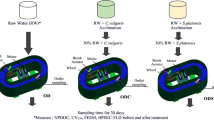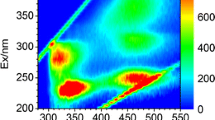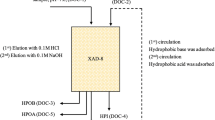Abstract
Integrated constructed wetland into activated sludge process has a potential in improving treated wastewater with high organic loading. However, biological activities on those processes will generate microbial by-products from substrate metabolism and cell lysis. The presence of those compounds in effluent of wastewater treatment causes problems in source water. This study combines fluorescence excitation emission matrices (FEEM) with high-performance size exclusion chromatography with fluorescence detector (HPSEC-FLD) to characterize molecular weight–based fluorescent of organic matter and its removal in combination of constructed wetland with activated sludge process. The results show that three components of fluorescence organic: fulvic acid–like (Ex/Em 250/440 nm), SMP-like (Ex/Em 280/350 nm), humic acid–like (Ex/Em 340/420 nm), have been identified in all samples by the FEEM. Further, the HPSEC-FLD, which was set up based on chosen fluorescence wavelength, revealed two different apparent molecular weight (AMW) fractions: high molecular weight (HMW)/biopolymer (50,000 Da) and medium molecular weight (MMW)/humic substance–like (3000–650 Da). Peak-fitting determines that the area of MMW is higher than the area of HMW of all fluorescence organic components, and the area of HMW of fluorescence fulvic acid–like is comparable with the area of SMP-like, and no HMW of humic acid–like detected. Humic acid–like and fulvic acid–like were removed during treatment, while metabolite by-product were released as shown by increasing fluorescence SMP-like and TOC concentration. This method gives new insight to characterize organic matter for assessing effluent of wastewater quality and determining the appropriate water treatment.





Similar content being viewed by others
References
Akizuki, S., Nagao, N., & Toda, T. (2018). A multifunctional single-stage process for the effective methane recovery and denitrification of intermittently discharged wastes. International Biodeterioration and Biodegradation, 127, 201–208.
APHA, AWWA, & WEF. (2012). Standard methods for the examination of water and wastewaters (21th ed.). American Public Health Association: Washington, D.C.
Baghoth, S. A., Maeng, S. K., Salinas Rodríguez, S. G., Ronteltap, M., Sharma, S., Kennedy, M., & Amy, G. L. (2008). An urban water cycle perspective of natural organic matter (NOM): NOM in drinking water, wastewater effluent, storm water, and seawater. Water Science. Technology: Water Supply, 8(6), 701–707.
Chabaliná, L. D., Pastor, M. R., & Rico, D. P. (2013). Characterization of soluble and bound EPS obtained from 2 submerged membrane bioreactors by 3D-EEM and HPSEC. Talanta, 115, 706–712.
Chen, W., Westerhoff, P., Leenheer, J. A., & Booksh, K. (2003). Fluorescence excitation-emission matrix regional integration to quantify spectra for dissolved organic matter. Environmental Science and Technolology, 37(24), 5701–5710.
Chow, C. W. K., Fabris, R., van Leeuwen, J., Wang, D. S., & Drikas, M. (2008). Assessing natural organic matter treatability using high performance size exclusion chromatography. Environmental Science and Technology, 42, 6683–6689.
Clairmont, L. K., & Slawson, R. M. (2019). Contrasting water quality treatments result in structural and functional changes to wetland plant-associated microbial communities in lab-scale mesocosms. Microbial Ecology. https://doi.org/10.1007/s00248-019-01389-5.
Edzwald, J. K., & Tobiason, J. E. (2011). Chemical principles, source water composition, and watershed protection. In J. K. Edzwald (Ed.), Water quality & treatment: a handbook on drinking water (pp. 1–76). AWWA McGraw-Hill: New York.
Her, N., Amy, G., McKnight, D., Sohn, J., & Yoon, Y. (2003). Characterization of DOM as a function of MW by fluorescence EEM and HPLC-SEC using UVA, DOC, and fluorescence detection. Water Research, 37, 4295–4303.
Hidayah, E.N. & Cahyonugroho, O.H. (2019). Tracking of dissolved effluent organic matter (dEfOM) in wastewater treatment plant by using fluorescence method. IOP Conference Series: Earth and Environmental Science, 245(1).
Hidayah, E. N., Chen, Y. C., & Yeh, H. H. (2017). Comparison between HPSEC-OCD and F-EEMs for assessing DBPs formation in water. Journal of Environmental Science and Health Part A, 52(4), 391–402.
Huber, S. A., Balz, A., Abert, M., & Pronk, W. (2011). Characterisation of aquatic humic and non-humic matter with size-exclusion chromatography–organic carbon detection–organic nitrogen detection (LC-OCD-OND). Water Research, 45, 879–885.
Lai, C. H., Chou, Y. C., & Yeh, H. H. (2015). Assessing the interaction effects of coagulation pretreatment and membrane material on UF fouling control using HPSEC combined with peak-fitting. Journal of Membrane Science, 474, 207–214.
Li, W. T., Xu, Z. X., Li, A. M., Wu, W., Zhou, Q., & Wang, J. N. (2013). HPLC/HPSEC-FLD with multi-excitation/emission scan for EEM interpretation and dissolved organic matter analysis. Water Research, 47(3), 1246–1256.
Liu, J. L., Li, X. Y., Xie, Y. F., & Tang, H. (2014). Characterization of soluble microbial products as precursors of disinfection byproducts in drinking water supply. Science of the Total Environment, 472, 8818–8824.
Liu, R., Zhao, Y., Doherty, L., Hu, Y., & Hao, X. (2015). A review of incorporation of constructed wetland with other treatment processes. Chemical Engineering Journal, 279, 220–230.
Matilainen, A., Gjessing, E. T., Lahtinen, T., Hed, L., Bhatnagar, A., & Sillanpää, M. (2011). An overview of the methods used in the characterisation of natural organic matter (NOM) in relation to drinking water treatment. Chemosphere, 83(11), 1431–1442.
Metcalf, & Eddy. (2002). Wastewater engineering: treatment and reuse. Education: McGraw-Hill.
Moradi, S., Sawade, E., Aryal, R., Chow, C. W. K., van Leeuwen, J., Drikas, M., Cook, D., & Amal, R. (2018). Tracking changes in organic matter during nitrification using fluorescence excitation-emission matrix spectroscopy coupled with parallel factor analysis (FEEM/PARAFAC). Journal of Environmental Chemical Engineering, 6(1), 1522–1528.
Nagao, S., Matsunaga, T., Suzuki, Y., Ueno, T., & Amano, H. (2003). Characteristics of humic substances in the Kuji River waters as determined by high-performance size exclusion chromatography with fluorescence detection. Water Research, 37(17), 4159–4170.
Ni, B. J., Zeng, R. J., Fang, F., Xie, W. M., Sheng, G. P., & Yu, H. Q. (2010). Fractionating soluble microbial products in the activated sludge process. Water Research, 44, 2292–2302.
Sgroi, M., Pelissari, C., Roccaro, P., Sezerino, P. H., García, J., Vagliasindi, F. G. A., & Ávila, C. (2018). Removal of organic carbon, nitrogen, emerging contaminants and fluorescing organic matter in different constructed wetland configurations. Chemical Engineering Journal, 332, 619–627.
Shon, H. K., Vigneswaran, S., & Snyder, S. A. (2012). Effluent organic matter (EfOM) in wastewater: constituents, effect, and treatment. Critical Reviews in Environmental Science and Technology, 36(4), 327–374.
Sillanpää, M., Matilainen, A., & Lahtinen, T. (2015). Characterization of NOM. In M. Silaanpää (Ed.), Natural organic matter in water: characterization and treatment method (pp. 17–53). Butterworth-Heinemann: Oxford.
Su, Y., Wang, W., Wu, D., Huang, W., Wang, M., & Zhu, G. (2018). Stimulating ammonica oxidizing bacteria activity drives the ammonium oxidation rate in a constructed wetland. Science of the Total Environment, 624, 87–95.
Vymazal, J. (2018). Constructed wetlands for wastewater treatment. In; Encyclopedia of ecology, 2nd Edition, Bryan Fath, Elsevier.
Wu, H. M., Zhang, J., Ngo, H. H., Guo, W. S., Hu, Z., Liang, S., Fan, J. L., & Liu, H. (2015). A review on the sustainability of constructed wetlands for wastewater treatment: design and operation. Bioresource Technology, 175, 594–601.
Wünsch, U., Murphy, K. R., & Stedmon, C. (2015). Fluorescence quantum yields of natural organic matter and organic compounds: implications for the fluorescence-based interpretation of organic matter composition. Frontiers in Marine Science, 2, 1–15.
Xiao, K., Shen, Y. X., Sun, J. Y., Liang, S., Fan, H. J., Tan, J. H., Wang, X. M., Huang, X., & Waite, T. D. (2018). Correlating fluorescence spectral properties with DOM molecular weight and size distribution in wastewater treatment systems. Environmental Science Water Research and Technology, 4, 1933–1943.
Xie, W. M., Ni, B. J., Seviour, T., Shen, G. P., & Yu, H. Q. (2012). Characterization of autotrophic and heterotrophic soluble microbial product (SMP) fractions from activated sludge. Water Research, 46, 6210–6217.
Xie, W. M., Ni, B. J., Sheng, G. P., Seviour, T., & Yu, H. Q. (2016). Quantification and kinetic characterization of soluble microbial products from municipal wastewater treatment plants. Water Research, 88, 703–710.
Yalcuk, A., & Ugurlu. (2009). Comparison of horizontal and vertical constructed wetland systems for landfill leachate treatment. Bioresource Technology, 100, 2521–2526.
Yao, Y., Li, Y. Z., Zhang, Y. P., Guo, X. J., & Yuan, F. (2016). Changes and characteristics of dissolved organic matter in a constructed wetland system using fluorescence spectroscopy. Environmental Science Pollution Research, 23, 12237–12245.
Zhiji, D., Bourven, I., van Hullebusch Panico, A., Pirozzi, F., Esposito, G., & Guibaud, G. (2017). Quantitative and qualitative characterization of extracellular polymeric substances from Anammox enrichment. Journal of the Taiwan Institute Chemical Engineers, 80, 738–746.
Funding
This research was financially supported by ASEAN-India Research Training Fellowship Program through Department Science and Technology (DST) and the Federation of Indian Chambers of Commerce and Industry (FICCI), India, with file no: RTF/2018/000021.
Author information
Authors and Affiliations
Corresponding author
Additional information
Publisher’s Note
Springer Nature remains neutral with regard to jurisdictional claims in published maps and institutional affiliations.
Electronic supplementary material
ESM 1
(DOCX 15 kb)
Rights and permissions
About this article
Cite this article
Hidayah, E.N., Pachwarya, R.B., Cahyonugroho, O.H. et al. Characterization of Molecular Weight–Based Fluorescent Organic Matter and Its Removal in Combination of Constructed Wetland with Activated Sludge Process. Water Air Soil Pollut 231, 41 (2020). https://doi.org/10.1007/s11270-020-4405-5
Received:
Accepted:
Published:
DOI: https://doi.org/10.1007/s11270-020-4405-5




